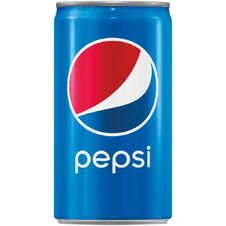
Pepsi is a carbonated soft drink manufactured by PepsiCo. Originally created and developed in 1893 by Caleb Bradham and introduced as Brad's Drink, it was renamed as Pepsi-Cola in 1898, and then shortened to Pepsi in 1961.
History[]
Pepsi was first introduced as "Brad's Drink" in New Bern, North Carolina, United States, in 1893 by Caleb Bradham, who made it at his drugstore where the drink was sold. It was renamed Pepsi-Cola in 1898 after the Greek word for "digestion" (πέψις, pronounced Pepsis), which the drink was purported to aid, and "cola" after the kola nut. The original recipe also included sugar and vanilla. Bradham sought to create a fountain drink that was appealing and would aid in digestion and boost energy.
In 1903, Bradham moved the bottling of Pepsi-Cola from his drugstore to a rented warehouse. That year, Bradham sold 7,968 gallons of syrup. The next year, Pepsi was sold in six-ounce bottles, and sales increased to 19,848 gallons. In 1909, automobile race pioneer Barney Oldfield was the first celebrity to endorse Pepsi-Cola, describing it as "A bully drink...refreshing, invigorating, a fine bracer before a race." The advertising theme "Delicious and Healthful" was then used over the next two decades.
In 1923, the Pepsi-Cola Company entered bankruptcy—in large part due to financial losses incurred by speculating on the wildly fluctuating sugar prices as a result of World War I. Assets were sold and Roy C. Megargel bought the Pepsi trademark. Megargel was unsuccessful in efforts to find funding to revive the brand and soon Pepsi's assets were purchased by Charles Guth, the president of Loft, Inc. Loft was a candy manufacturer with retail stores that contained soda fountains. He sought to replace Coca-Cola at his stores' fountains after the Coca-Cola Company refused to give him additional discounts on syrup. Guth then had Loft's chemists reformulate the Pepsi-Cola syrup formula.
On three separate occasions between 1922 and 1933, the Coca-Cola Company was offered the opportunity to purchase the Pepsi-Cola company, and it declined on each occasion.
Growth in popularity[]
During the Great Depression, Pepsi-Cola gained popularity following the introduction in 1934 of a 12-ounce bottle. Prior to that, Pepsi and Coca-Cola sold their drinks in 6.5-ounce servings for about $0.05 a bottle. With a radio advertising campaign featuring the popular jingle "Nickel, Nickel" – first recorded by the Tune Twisters in 1940 – Pepsi encouraged price-conscious consumers to double the volume their nickels could purchase. The jingle is arranged in a way that loops, creating a never-ending tune:
"Pepsi-Cola hits the spot / Twelve full ounces, that's a lot / Twice as much for a nickel, too / Pepsi-Cola is the drink for you."
Marketing[]
From the 1930s through the late 1950s, "Pepsi-Cola Hits The Spot" was the most commonly used slogan in the days of old radio, classic motion pictures, and later television. Its jingle (conceived in the days when Pepsi cost only five cents) was used in many different forms with different lyrics. With the rise of radio, Pepsi utilized the services of a young, up-and-coming actress named Polly Bergen to promote products, oftentimes lending her singing talents to the classic "...Hits The Spot" jingle.
Film actress Joan Crawford, after marrying Pepsi-Cola president Alfred N. Steele became a spokesperson for Pepsi, appearing in commercials, television specials, and televised beauty pageants on behalf of the company. Crawford also had images of the soft drink placed prominently in several of her later films. When Steele died in 1959, Crawford was appointed to the Board of Directors of Pepsi-Cola, a position she held until 1973, although she was not a board member of the larger PepsiCo, created in 1965.
Pepsi has been featured in several films, including Back to the Future (1985), Home Alone (1990), Wayne's World (1992), Fight Club (1999), and World War Z (2013).
In 1992, the Pepsi Number Fever marketing campaign in the Philippines accidentally distributed 800,000 winning bottle caps for a 1 million peso grand prize, leading to riots and the deaths of five people.
In 1996, PepsiCo launched the highly successful Pepsi Stuff marketing strategy. "Project Blue" was launched in several international markets outside the United States in April. The launch included extravagant publicity stunts, such as a Concorde aeroplane painted in blue colors (which was owned by Air France) and a banner on the Mir space station.